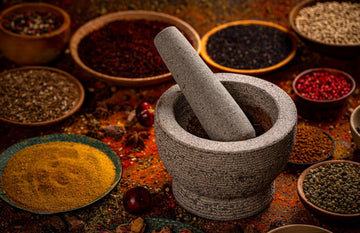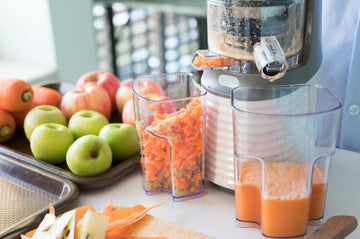Mortar and pestles have been a staple in kitchens for centuries, offering a hands-on way to grind, crush, and mix spices, herbs, and other ingredients. Unlike electric grinders, they allow you to control texture and intensity, giving more nuance to flavors in your cooking.
While they may seem old-fashioned in a world of modern appliances, mortar and pestles still hold value for anyone who wants to enhance the aroma and taste of fresh spices. In this article, we’ll explore how to use them effectively, what they’re best suited for, and even practical alternatives for those who want similar results with less effort.
What are mortar and pestles
A mortar and pestle is a simple kitchen tool consisting of a bowl, known as the mortar, and a heavy club-shaped object called the pestle. The mortar holds the ingredients while the pestle is used to crush, grind, and mix them. Though its design is straightforward, the tool offers precise control over texture, allowing you to go from coarse to fine depending on the dish.
Mortar and pestles come in a variety of materials, each suited to different tasks. Granite and marble versions are dense and ideal for crushing hard spices or making pastes, while ceramic and porcelain ones are better for softer ingredients, such as fresh herbs, that could stain or scratch the surface. Wooden mortar and pestles are lightweight and gentle but less effective for hard seeds or nuts. The weight and texture of the material influence how easily ingredients break down and how much effort is required.
What makes mortar and pestles unique is the tactile interaction they offer. Unlike electric grinders, which quickly pulverize spices, using a mortar allows for gradual grinding. This can release essential oils more evenly, intensifying flavor in a way that a mechanical grinder sometimes cannot replicate. Many chefs and home cooks appreciate this hands-on approach for creating spice blends, pesto, pastes, and marinades, giving the dishes a depth that pre-ground spices often lack.
How to use mortar and pestles

Using a mortar and pestle effectively is about technique as much as it is about strength. Start by placing a small amount of the ingredient in the mortar; overfilling can make grinding inefficient and uneven. For dry spices, begin by pressing down with the pestle and using a twisting motion, which crushes the seeds or grains against the textured surface of the mortar. This motion releases essential oils and flavors gradually, producing a more aromatic and flavorful result than simply pounding.
For herbs, garlic, or softer ingredients, a circular grinding motion is usually more effective. Press the pestle into the herbs and rotate, crushing them slowly to avoid bruising excessively or turning them into a paste too quickly. When making pastes, such as pesto or curry bases, it’s helpful to alternate between pressing and stirring, scraping down the sides as needed to ensure everything is evenly combined.
Timing and pressure matter. Too little force, and ingredients won’t break down fully; too much, and you risk over-grinding delicate herbs or splattering small seeds. It’s a balance that improves with practice. Start with a few trials using less expensive spices to get a feel for how much pressure and movement is needed to achieve coarse, medium, or fine textures.
Once you master the basic technique, mortar and pestles can be used for a variety of tasks—from crushing peppercorns for fresh seasoning, grinding cumin or coriander for spice blends, to creating pastes for sauces and marinades. The tactile feedback gives a level of control that electric grinders cannot replicate, making it an indispensable tool for chefs who value precision and flavor nuance.
How to clean mortar and pestles
Proper cleaning of a mortar and pestle is essential to maintain its performance and prevent flavor contamination between uses. The method depends largely on the material of your mortar. For stone or granite versions, start by wiping out any loose particles with a dry cloth or paper towel. Then, rinse the mortar and pestle under warm water without using soap, which can absorb into the porous surface and affect the taste of future ingredients. Use a stiff brush or a sponge to gently scrub away any stubborn residue.
For ceramic or porcelain mortars, soap can be used safely, but avoid harsh detergents that may scratch or weaken the material. Wooden mortar and pestles require extra care: rinse them with warm water and wipe dry immediately. Avoid soaking wood, as this can lead to cracking or warping over time.
After cleaning, it’s beneficial to let the mortar and pestle air-dry completely before storing. For stone versions, occasionally rubbing a small amount of neutral cooking oil into the surface helps maintain smoothness and prevents the porous stone from absorbing moisture. Regular maintenance ensures that your mortar and pestle remains effective and hygienic for years of grinding and crushing.
What spices and herbs are great for mortar & pestles

Mortar and pestles excel at breaking down a wide range of spices and herbs, giving them fresher, more potent flavors than pre-ground alternatives. Hard spices such as peppercorns, cumin seeds, coriander seeds, and mustard seeds respond particularly well to the crushing action, releasing their essential oils and aromas more fully than a quick electric grind. Grinding these spices just before use can noticeably enhance the taste of curries, soups, and marinades.
Soft herbs and leafy greens, like basil, cilantro, and mint, are also ideal candidates. Using a gentle pressing and circular motion, you can turn these herbs into fine pastes or aromatic blends for sauces, dressings, and dips. Garlic, ginger, and chilies can be combined with soft herbs to create pastes for marinades, curry bases, or seasoning blends. The tactile control of the mortar and pestle allows you to achieve the exact texture you need, whether a coarse crush or smooth paste.
Spices that are oily or resinous, like nutmeg or star anise, benefit from the even pressure of a mortar and pestle, which grinds them without overheating and losing volatile compounds. In general, any ingredient where flavor intensity and texture matter is suitable for this tool. By experimenting with different spices and herbs, you can develop custom blends and pastes that bring out nuances often lost in pre-packaged products.
Alternatives for mortar & pestles
While mortar and pestles offer unmatched tactile control and texture, there are several alternatives for those who prefer faster or more convenient methods. Electric spice grinders are the most common substitute, allowing you to grind large quantities of spices quickly and consistently. They work well for dry spices like peppercorns, cumin, or coriander, but may not produce the same coarse-to-fine versatility that a mortar allows. Additionally, the rapid grinding can generate heat, which slightly alters the flavor of delicate spices.
A blender or food processor can be used for larger batches or when making pastes that combine both herbs and liquids. While effective, these tools are less precise, and over-processing can lead to overly smooth textures that lose the rustic quality a mortar provides.

For softer herbs or small quantities, a rolling pin and plastic bag method can be surprisingly effective. Place herbs or seeds in a sealed bag and crush with a rolling pin, applying steady pressure. It’s less elegant than a mortar, but it works for light crushing and releases essential oils in a pinch.
Despite these alternatives, a mortar and pestle still has unique advantages: control over texture, ability to grind small amounts efficiently, and preservation of aromatic oils. For those who prefer convenience without sacrificing quality, pairing a mortar and pestle with an electric spice grinder can offer the best of both worlds: use the mortar for precise, small-batch tasks and the grinder for quick, larger quantities.
Why a mortar and pestle still matters
Even in an age of electric grinders and high-speed blenders, a mortar and pestle remains a valuable tool for anyone serious about flavor. Its simplicity allows you to control texture, intensity, and aroma in ways that machines cannot replicate. From grinding hard spices to creating fresh herb pastes, it provides precision, versatility, and a tactile connection to your ingredients that enhances the cooking experience. While alternatives like electric grinders offer speed and convenience, the mortar and pestle continues to hold its place in kitchens for hands-on, nuanced culinary work. Combining it with modern tools can give you the best of both worlds, ensuring every dish benefits from both efficiency and depth of flavor.





